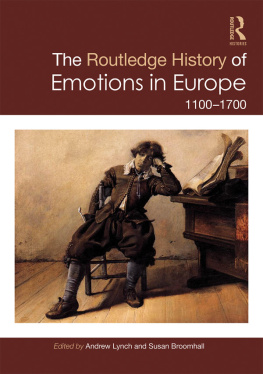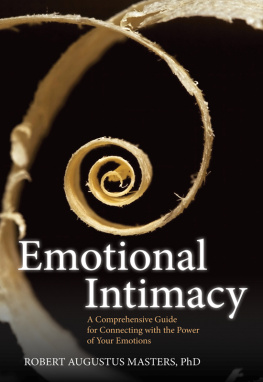
A CULTURAL HISTORY
OF THE EMOTIONS
VOLUME 3
A Cultural History of the Emotions
General Editors: Susan Broomhall, Jane W. Davidson, and Andrew Lynch
Volume 1
A Cultural History of the Emotions in Antiquity
Edited by Douglas Cairns
Volume 2
A Cultural History of the Emotions in the Medieval Age
Edited by Juanita Ruys and Clare Monagle
Volume 3
A Cultural History of the Emotions in the Late Medieval, Reformation, and Renaissance Age
Edited by Andrew Lynch and Susan Broomhall
Volume 4
A Cultural History of the Emotions in the Baroque and Enlightenment Age
Edited by Claire Walker, Katie Barclay, and David Lemmings
Volume 5
A Cultural History of the Emotions in the Age of Romanticism, Revolution, and Empire
Edited by Susan Matt
Volume 6
A Cultural History of the Emotions in the Modern and Post-Modern Age
Edited by Jane Davidson and Joy Damousi

CONTENTS
INTRODUCTION
CHAPTER 1
CHAPTER 2
CHAPTER 3
CHAPTER 4
CHAPTER 5
CHAPTER 6
CHAPTER 7
CHAPTER 8
The General Editors, volume editors, and individual authors of this series have many organizations to thank for helping to bring it into existence. They gratefully acknowledge assistance from the Arts and Humanities Research Council (UK); the European Research Council Project, The Social and Cultural Construction of Emotions, University of Oxford, and its Director, Professor Angelos Chaniotis; the Leverhulme Trust; and the Wellcome Trust. Above all, the series has depended on support from the Australian Research Council Centre of Excellence for the History of Emotions (CE110001011). The project was conceived as a key part of the Centres collaborative research work and has benefited greatly from the generous help of its academic and administrative staff.
The General Editors also express their deep gratitude to the volume editors and authors for their time, expertise and gracious willingness to revise essays in the light of readers comments. Many other people helped in reading, tracing images, and advising in various ways. Our thanks go to Merridee Bailey; Jacquie Bennett; Sophie Boyd-Hurrell; Frederic Kiernan; Mark Neuendorf; Fiona Sim; and Stephanie Thomson; and to the patient staff at Bloomsbury: Dan Hutchins; Claire Lipscomb; Beatriz Lopez; and Rhodri Mogford. We especially acknowledge Ciara Rawnsley, who as Editorial Assistant for the entire series has tirelessly helped authors and done indispensable and meticulous work on all aspects of the volumes preparation.
This series is dedicated to the memory of Philippa Maddern (19522014) who was an original General Editor, and an inspiring friend, mentor and colleague to many of the contributors.
ANDREW LYNCH
What goes to make up a cultural history of the emotions? There could be as many answers to that question as there are forms for understanding, expressing, and enacting how emotions have existed in the known world. One starting point might be to note that the question in itself assumes that emotions, as well as culture, have a history. And given that this volume covers the years 13001600 CE , in a series stretching from European antiquity to the present, a further assumption must be that they have a long history, meaning that they are seen as continuing and changing elements of life.
Emotions have a history in the sense that we find their place in the record of life inextricably entangled with factors of historical difference, across time, place, and culture. To say that they have a cultural history is basically to say that they are generated, experienced, expressed, shared, understood, and later observed and interpreted within cultural contexts, amongst many others. Emotions both help to make up these cultural contexts and are made within them in an endless, always fluid, interactive process. Not all definitions of culture have taken this view. Raymond Williams once restricted the words usefulness to responses in thought and feeling to the changes in English society since the late eighteenth century (Williams 1960: v). But, writing more generally, he advocated
a social definition of culture, in which culture is a description of a particular way of life, which expresses certain meanings and values not only in art and learning but also in institutions and ordinary behaviour. The analysis of culture, from such a definition, is the clarification of the meanings and values implicit and explicit in a particular way of life, a particular culture. Such analysis will also include analysis of elements in the organization of production, the structure of the family, the structure of institutions which express or govern social relationships, the characteristic forms through which members of the society communicate.
Williams 1961: 578
It will be clear from the chapter structure in each volume of this series, which includes medicine and science, religion, and private and public life, along with music and dance, drama, the visual arts, and literature that we are taking up the analysis of culture in something like Williamss social sense.
It is in that sense also, implying both a broad disciplinary outlook and a concern with the specifics of cultural forms and discourses, social structures, and institutional arrangements, that essays in this volume treat 13001600 as a historical section of European culture. In doing so we are conscious of transgressing long-standing period boundariesbetween medieval and Renaissance, or medieval and early modern. We have done this consciously, taking the view that looking at cultural history through emotions offers new opportunities for examining the complexities of historical situations, their patterns of influence and difference, and the nature of change. This volume emphasizes the emotional impact of new expressive forms in art, music, dance, and drama, and their complex ties to court, church, and city. Thinking about emotions in relation to cultural forms casts further light on traditional features of periodic change, like the Reformation, humanism or the rise of the nation state. Yet our essays also show clearly that some major cultural practices of emotion, such as popular demonstrations of discontent with authority, or rituals surrounding childbearing, were prevalent across all the centuries and many of the locations we review. Manuscript production did not cease with the onset of printed books, and printed books spread material that was popular in manuscripts. Similarly, poetic forms such as the sonnet and the neo-Latin epic held sway throughout our period. While we know that there was widespread disruption and disturbance of long-standing ideas, institutions, forms, customs, and ways of life (Salmon 1975; Duffy 1992; Greengrass 2014), there are also evidences of strong cultural continuities.
Clearly, emotional cultures do not march in lockstep with the traditional temporal landmarks of European history; that is part of the value of studying them. Nevertheless emotions, both past and present, have played a large part in establishing modern feelings about historical periodization. The period 13001600 is a time in which scholarly and confessional discourses, which overlapped with political discourses, oriented themselves toward the past as a different time, and thought about it in terms of communicating across a void or celebrating a liberation. Petrarch, writing to Seneca (d. 65 CE ) in the mid-fourteenth century, has been described as disclos[ing] his awareness of the gap that separates him from his addressee, a gulf which he hopes to bridgeas the very writing of the letter showsby new practices of reading and writing (Gur 2015: 141). In the field of art, an idea developed of the great master as an individual, an innovator, surpassing earlier achievements. In 1550, Giorgio Vasari referred to Masaccio (14011428) as one who swept away completely the manner of Giotto and gave a beginning to beautiful attitudes, movements, liveliness, and vivacity, and to a certain relief truly characteristic and natural; which no painter up to his time had ever done (Vasari 1912: 86). These notions empowered new versions of cultural authority, and helped to create an emotional break with the recent past. From the later fourteenth century onwards, artists and architects increasingly hearkened back to the classical world for their aesthetic reference points, while humanist writers in Latin copied classical models and began to study Greek. There was a growing scholarly emphasis on the primacy of original scriptural texts and the early church Fathers, and a project to clear away intervening commentaries. These movements took place alongside attempts, often resisted, to promote the bible to lay people in the vernacular.
Next page














